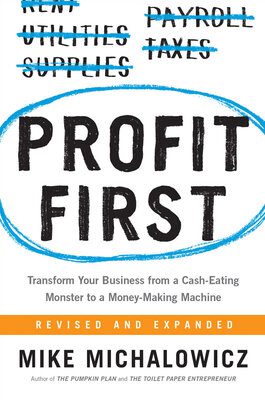Without an understanding of profitability, every business, no matter how big, no matter how “successful,” is a house of cards
In Profit First: Transform Your Business from a Cash-Eating Monster to a Money-Making Machine, Small Business author Mike Michalowicz describes a framework that he calls “Profit First”. It is a behavioral approach to accounting wherein the entrepreneur takes profit first and appropriates only what remains for expenses. Mike noted that by following this approach, entrepreneurs will transform their businesses from cash-eating monsters to profitable cash cows.
A financially healthy company is a result of a series of small daily financial wins, not one big moment. Profitability isn’t an event; it’s a habit.
Profit First is not about accounting to the exact penny. That’s what your bookkeeper and accountant do. It is about handling your accounting quickly and easily with numbers that are as close to accurate as possible.
As a heart pumps blood rhythmically, forming a heartbeat, the lifeblood of your business, money should flow in a similar rhythm, not in a random, panicky pump here and there whenever you have funds.
Conventional Accounting
Relying on traditional accounting methods to grow profitability is the equivalent of telling you to jump off a cliff and flap the living crap out of your arms. Maybe two or three of the millions of people who try it, by some miracle, live. But pointing to the miraculous survivors and saying, “See? This works!” is ludicrous. Millions die and a few survive, yet we blindly say the arm-flapping, cliff-jumping system is the best way to fly.
Old Formula: General Accounting
Sales − Expenses = Profit
The old profit formula creates monsters of businesses. Cash-eating monsters. But we stay loyal to the formula, and things get worse. The solution is profoundly simple: Take your profit first.
We focus on what comes first (sales and expenses) and actually become blind to what comes last. Yes, GAAP makes us blind to profit.
Generally Accepted Accounting Principles (GAAP)
GAAP’s fundamental flaw is that it goes against human nature. No matter how much income we generate, we will always find a way to spend it—all of it. And we have good reasons for all our spending choices. Everything is justified. Soon enough, whatever money we had in the bank dwindles down to nothing as we struggle to cover every “necessary” expense. And that’s when we find ourselves in the Survival Trap.
GAAP is a collection of commonly-followed accounting rules and standards for financial reporting.
Money Problems
Money is the foundation. Without enough money, we cannot take our message, our products, or our services to the world. Without enough money, we are slaves to the businesses we launched. I find this hilarious because, in large part, we started our businesses because we wanted to be free.
Without enough money, we cannot fully realize our authentic selves. Money amplifies who we are. There isn’t a single ounce of doubt in my mind that there is something big you are intended to do on this planet. You wear the cape of what I believe is the greatest of all superheroes: the Entrepreneur. But your superhero powers can only yield as much power as your energy source provides. Money. You need money, superhero.
Money problems occur when one of two things happen: Sales slow down or Sales speed up
Profit
Profit
Profit is not an event. Profit is not something that happens at year-end or at the end of your five-year plan or someday. Profit isn’t even something that waits until tomorrow. Profit must happen now and always. Profit must be baked into your business. Every day, every transaction, every moment. Profit is not an event. Profit is a habit.
Revenue is vanity, profit is sanity, and cash is king
Reverse Engineer Profit
Here’s the reality if you want healthy, sustainable growth—which, not so surprisingly, will spawn more healthy growth—you need to reverse engineer the profit. Take profit first. You can’t grow out of your profit problem. You need to fix profit first, then grow. You must figure out the things that make profit and dump the things that don’t.
When you focus on growth, it is inevitably a scramble to grow at all costs. Yes, at all costs (including the quality of your life). When you focus on profit first, you inevitably figure out how to make a profit consistently. Profitability. Stability. Sanity. Forevermore.
Bank Balance Accounting
You look at your bank balance and see a chunk of change. Yippee! You feel great for about ten minutes, and then decide to pay all the bills that have been piling up. The balance goes to zero and very quickly you feel that all-too-familiar tightening in the chest.
We use the money we have to pay the bills we owe; when we don’t have enough to cover everything, we try to get more money through sales and collections. Except that to support new revenue, we now have a host of new related expenses, so the cycle starts all over again. If you haven’t relied on it from the start, eventually the only “solution” is to take on debt—a second mortgage on your family home, a line of credit tied to your building, a stack of credit cards three inches high. This is how many entrepreneurs end up operating their businesses check to check and panic to panic.
TRADITIONAL ACCOUNTING IS KILLING YOUR BUSINESS”
Sales – Expenses = Profit
If you manage the numbers like most entrepreneurs, you start with sales (the top line) and then subtract costs directly related to the delivery of your offering (product or service). Then you subtract all the other costs you incur to run your business: rent, utilities, employee salaries, office supplies, and other administrative expenses, sales commissions, taking your client out to lunch, signage, insurance, etc., etc. Then you pay taxes. Then, and only then, do you take your owner’s distribution (owner’s salary, profit distribution, etc.).
We do everything we can to make the top line (revenue) grow so that something, anything, will drip down to the bottom line. It becomes a relentless cycle of chasing after every shiny object disguised as opportunity.
Parkinson Law
In 1955, a modern philosopher named C. Northcote Parkinson came up with the counterintuitive Parkinson’s Law: that the demand for something expands to match its supply. In economics, this is called induced demand—it’s why expanding roads to reduce traffic congestion never works in the long term because more drivers always show up in their cars to fill those extra lanes.
Similarly, if your client gives you a week to turn around a project, you’d likely take the whole week—but if she gives you just a day, you’ll make it happen in a day.
You see the more we have of something, the more of it we consume. This is true for anything: food, time, even toothpaste.
If there is one thing that will forever change your relationship with money, it is the understanding of Parkinson’s Law. You need to intentionally make less toothpaste (mon“ey) available to brush your teeth (to operate your business). When there is less, you will automatically run your business more frugally (that’s good) and you will run your business far more innovatively (that’s great!).
If you first extract your profit and remove it from sight, you’ll be left with a nearly empty toothpaste tube to run your business. When less money is available to run your business, you will find ways to get the same or better results with less. By taking your profit first, you will be forced to think smarter and innovate more.
The Primacy Effect
The second behavioral principle you need to understand about yourself is called the Primacy Effect. The principle is this: We place additional significance on whatever we encounter first.
We place additional significance on whatever we encounter first.
When we follow the conventional formula of Sales − Expenses = Profit, we are primed to focus on those first two words, Sales and Expenses, and treat Profit as an afterthought. We then behave accordingly. We sell as hard as we can, then use the money we collect to pay expenses. We stay stuck in the cycle of selling to pay bills, over and over again, wondering why we never see any profit.
When profit comes first, it is the focus, and it is never forgotten.
Remove Temptation: Once You Take Your Profit First, Put It Away”
Money works the same way. As you implement Profit First, you are going to use the powerful force of “out of sight, out of mind.” As you generate a profit (which, remember, starts today), you are going to remove the money from your immediate access. You won’t see it, so you won’t access it. And just like anything that you don’t have a reasonable degree of access to, you will find a way to work with what you do have and not worry about what you don’t.
Be the best at one thing
To grow the biggest and the fastest, you need to be the best at one thing you do. And to become the best at something, you need to first determine what you are best at and do it a whole lot better. To get there, you take your profit first and the answers to being the best at something will reveal themselves.
THE Profit First ACCOUNTING FORMULA
Sales − Profit = Expenses
The Five foundational Accounts
Profit is a reward for equity owners, and Owner’s Comp is the pay for people who are owner operators in the business.
Here are the five checking accounts you need to set up: INCOME, PROFIT, OWNER’S COMP, TAX, and OPEX.
Denial is a wonderful thing; it lets you ignore reality until reality punches you in the face.
Real Revenue vs Gross Profit
Real Revenue is different from gross profit, in that Real Revenue is your total revenue minus materials and subcontractors utilized to create and deliver the service or product. Gross profit, on the other hand, is an accounting term calculated as total revenue minus materials, subcontractors, and any of your employees’ time utilized to create and deliver the service or product. It is a subtle difference but a critically important one.
Gross profit includes a portion of your employees’ time and your time. But the important thing is this: you will generally pay your employees for their time regardless of whether you have a bad sales day or good one.
A financially healthy company is a result of a series of small daily financial wins, not one big moment. Profitability isn’t an event; it’s a habit.
The Defining Moment
We can trace almost every major change to a pivotal moment when the pain of staying a certain way is greater than the effort to make awareness of it go away. Call it a turning point or a wake-up call, the choice is the same.
Well-dressed poverty is still poverty. Just because your business is making lots of money doesn’t mean you’re hanging on to it.
Profit is a slippery animal. When profit margins are big, usually in excess of 20 percent, people sniff out and almost immediately start to duplicate what you’re doing, and they look for ways to do it better, faster, and above all, cheaper than your company.
The idea behind the entire Profit First system is that it puts your decisions well out in front of any money crisis. Your business dynamics may not, in fact, improve; but your decision-making will be much further out in front of the actual financial impact. So the goal of the Vault is not to buy time; it may afford some time to address unexpected challenges, but it is really about forcing important decisions early, so your business doesn’t go into a cash crisis.



Comments are closed.